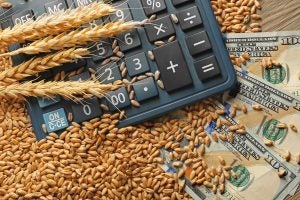Over the past year or so, if you have listened to or watched any kind of news about the outside world, you have heard two words/phrases:
1. Inflation
2. The Fed
Most people understand very little about either, and their understanding is that inflation is bad and the Fed is trying to fix it. And that’s correct. There’s also, as I’m sure everyone has guessed, a bit more to it than that.
Because of the field that I work in, (which is much different than the *actual field* most AGDAILY readers work in) I often make the mistake of assuming that everyone spends as much time on financial news and concepts as I do. Most people don’t because it’s not their job and they’re not sadists. So, I’ll invite you into the mind of someone who works in finance and give you an overview of what the Fed is doing and what it might mean for production agriculture.

First, the inflation issue. Inflation is too much available money chasing too few goods and services. When we have money and need things, and those things are scarce, we’re willing to pay more money for them. Sellers and suppliers oblige and charge more for their scarce goods. Buyers begin to feel more pressure to acquire what they need and tolerate price increases. It’s as much a psychological phenomenon as it is a market force.
Since the economy is one big marketplace where goods and services are exchanged for money, price pressures affect the whole machine. Enter, central banks.
Central banks, such as the American Federal Reserve (or simply, the Fed), control the supply of money through lending the government’s treasury balances, buying them back, and charging other banks to use the government’s money. They’re central to a fiat monetary system, hence the term “central bank.”
The primary driver of economic growth at any point in the cycle is access to capital. Banks provide capital through lending. Farmers, ranchers, business owners, and consumers use capital to expand economic activity. Businesses do this through purchasing and hiring. Consumers do this by purchasing more of the things businesses make. If capital is more expensive, and harder to get, it slows the economic machine. Businesses find it more expensive to operate because their interest expense has risen. Consumers can’t afford major purchases because of the cost of borrowing. They buy less from businesses, who then adjust by cutting production and jobs. Fewer people working makes less money available for purchasing, which drives down demand for goods and services, and lower demand is supposed to bring down prices.
This is the basic point: the Fed hopes to slow the economy by making money more expensive, reducing demand, and therefore lowering prices. We’ve been through this cycle before, and we’ll go through it again. This time has a few differentiating factors compared to other historical cycles, but that gets pretty wonky and it’s a topic unto itself.
And now to the crux of the matter: What does this mean for production agriculture?
I think there are three core actionable lessons:
- Now, as always but perhaps more than ever, leverage wisely. I’m not a member of the school of thought that says debt is always bad and should always be avoided. However, in a rising rate environment such as this one, a more detailed and realistic analysis of the operation’s needs and the cost of borrowing, in addition to the tax consequences associated with any decisions, should be conducted and continually evaluated.
- It’s been my observation both in my career and in my time growing up in a farm equipment dealership that production agriculturalists are really good at lamenting the bad times and really bad at planning for them. Every business and every economy goes through peaks and troughs, and the ones that thrive for generations expect the tough years and find opportunities to weatherproof their businesses. Save cash, hedge bets, dig in when other people are bailing out. This too shall pass.
- Understand that some of the price increases we’ve seen, particularly for inputs, are here to stay. Remember the last time we saw five-dollar diesel? I do. I also remember that fuel surcharges started to appear on freight invoices. Per mile rates went up. And I’ve haven’t seen those increases go away because the commodity input cost came back down. Build higher prices into your long-term plans. Expectations are a huge part of pricing, and this cycle just like the last one has taught us to expect higher costs and some of it isn’t going away.
I hope this helps shed some light on what has been a predominate topic of conversation, and provides some useful food for thought in order to make the best decisions for your operation regardless of the economic factors outside your control. We’re better when we’re better informed, and I wish you and your team of financial professionals the best going forward.
Katie Ogden owns and operates Wildcatter Wealth Management LLC in Laramie, Wyoming. She’s a 2007 graduate of the University of Wyoming with a bachelor’s degree in Agriculture Business and has been working in financial services to help ranch and farm families ensure a prosperous future ever since.



